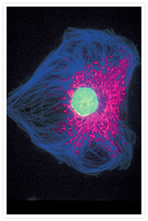Search Thermo Fisher Scientific
- Order Status
- Quick Order
-
Don't have an account ? Create Account
Search Thermo Fisher Scientific
Muntjac cells were treated with 10 µM EdU (Cat. No. A10044) for 45 min; cells were then fixed and permeabilized, and EdU that had been incorporated into newly synthesized DNA was detected using the far red–fluorescent Click-iT™ EdU Alexa Fluor® 647 High-Throughput (HCS) Assay (Cat. No. A10208), utilizing the technical tip for converting the HCS assay to conventional fluorescence microscopy. Tubulin was labeled with an anti-α-tubulin antibody (Cat. No. A11126) and visualized with Alexa Fluor® 350 Goat Anti–Mouse IgG (Cat. No. A11045, A21049). The Golgi complex was stained with green-fluorescent Alexa Fluor® 488 conjugate of lectin HPA from Helix pomatia (edible snail) (Cat. No. L11271), and peroxisomes were labeled with an anti-peroxisome antibody and visualized with orange-fluorescent Alexa Fluor® 555 Donkey Anti–Rabbit IgG (Cat. No. A31572).

A prometaphase muntjac skin fibroblast stained with Alexa Fluor® 350 phalloidin, an anti–a-tubulin antibody and an anti–cdc6 peptide antibody. Go ›

Bovine pulmonary artery endothelial cells (BPAEC). MitoTracker® Red CMXRos, SYTOX® Green nucleic acid stain, biotin-XX goat anti–mouse IgG antibody and Cascade Blue® NeutrAvidin biotin-binding protein. Go ›

1% Agarose gel containing 16S and 23S ribosomal RNA (rRNA). SYBR® Green II RNA gel stain. Go ›

Endothelial cells. Go ›

BPAE cells fixed and permeabilized using the Image-iT® Fixation/Permeabilization Kit. Go ›

BPAE cells fixed and permeabilized using the Image-iT® Fixation/Permeabilization Kit. Go ›
